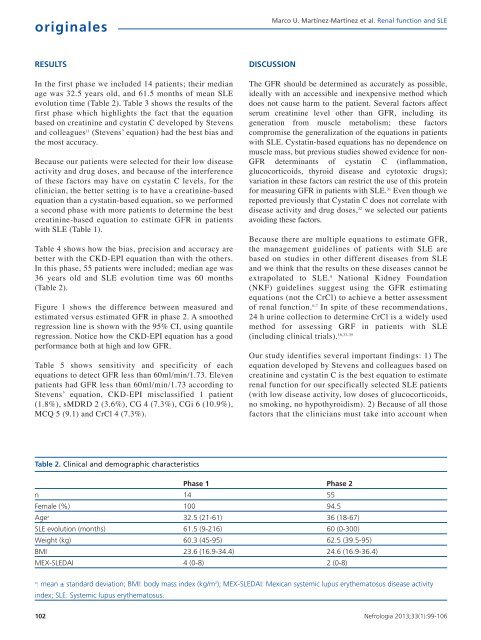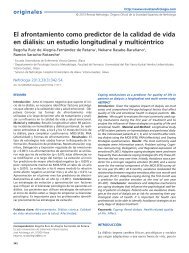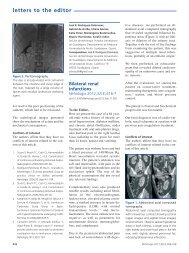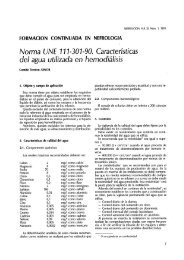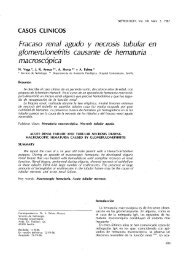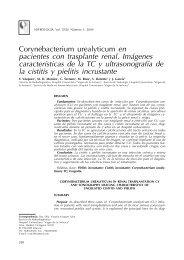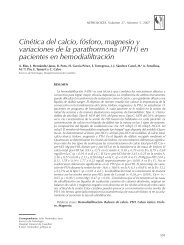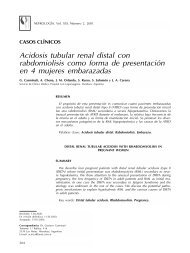PDF Número - NefrologÃa
PDF Número - NefrologÃa
PDF Número - NefrologÃa
You also want an ePaper? Increase the reach of your titles
YUMPU automatically turns print PDFs into web optimized ePapers that Google loves.
originales<br />
Marco U. Martínez-Martínez et al. Renal function and SLE<br />
RESULTS<br />
In the first phase we included 14 patients; their median<br />
age was 32.5 years old, and 61.5 months of mean SLE<br />
evolution time (Table 2). Table 3 shows the results of the<br />
first phase which highlights the fact that the equation<br />
based on creatinine and cystatin C developed by Stevens<br />
and colleagues 11 (Stevens’ equation) had the best bias and<br />
the most accuracy.<br />
Because our patients were selected for their low disease<br />
activity and drug doses, and because of the interference<br />
of these factors may have on cystatin C levels, for the<br />
clinician, the better setting is to have a creatinine-based<br />
equation than a cystatin-based equation, so we performed<br />
a second phase with more patients to determine the best<br />
creatinine-based equation to estimate GFR in patients<br />
with SLE (Table 1).<br />
Table 4 shows how the bias, precision and accuracy are<br />
better with the CKD-EPI equation than with the others.<br />
In this phase, 55 patients were included; median age was<br />
36 years old and SLE evolution time was 60 months<br />
(Table 2).<br />
Figure 1 shows the difference between measured and<br />
estimated versus estimated GFR in phase 2. A smoothed<br />
regression line is shown with the 95% CI, using quantile<br />
regression. Notice how the CKD-EPI equation has a good<br />
performance both at high and low GFR.<br />
Table 5 shows sensitivity and specificity of each<br />
equations to detect GFR less than 60ml/min/1.73. Eleven<br />
patients had GFR less than 60ml/min/1.73 according to<br />
Stevens’ equation, CKD-EPI misclassified 1 patient<br />
(1.8%), sMDRD 2 (3.6%), CG 4 (7.3%), CGi 6 (10.9%),<br />
MCQ 5 (9.1) and CrCl 4 (7.3%).<br />
DISCUSSION<br />
The GFR should be determined as accurately as possible,<br />
ideally with an accessible and inexpensive method which<br />
does not cause harm to the patient. Several factors affect<br />
serum creatinine level other than GFR, including its<br />
generation from muscle metabolism; these factors<br />
compromise the generalization of the equations in patients<br />
with SLE. Cystatin-based equations has no dependence on<br />
muscle mass, but previous studies showed evidence for non-<br />
GFR determinants of cystatin C (inflammation,<br />
glucocorticoids, thyroid disease and cytotoxic drugs);<br />
variation in these factors can restrict the use of this protein<br />
for measuring GFR in patients with SLE. 31 Even though we<br />
reported previously that Cystatin C does not correlate with<br />
disease activity and drug doses, 32 we selected our patients<br />
avoiding these factors.<br />
Because there are multiple equations to estimate GFR,<br />
the management guidelines of patients with SLE are<br />
based on studies in other different diseases from SLE<br />
and we think that the results on these diseases cannot be<br />
extrapolated to SLE. 8 National Kidney Foundation<br />
(NKF) guidelines suggest using the GFR estimating<br />
equations (not the CrCl) to achieve a better assessment<br />
of renal function. 6,7 In spite of these recommendations,<br />
24 h urine collection to determine CrCl is a widely used<br />
method for assessing GRF in patients with SLE<br />
(including clinical trials). 16,33-35<br />
Our study identifies several important findings: 1) The<br />
equation developed by Stevens and colleagues based on<br />
creatinine and cystatin C is the best equation to estimate<br />
renal function for our specifically selected SLE patients<br />
(with low disease activity, low doses of glucocorticoids,<br />
no smoking, no hypothyroidism). 2) Because of all those<br />
factors that the clinicians must take into account when<br />
Table 2. Clinical and demographic characteristics<br />
Phase 1 Phase 2<br />
n 14 55<br />
Female (%) 100 94.5<br />
Age a 32.5 (21-61) 36 (18-67)<br />
SLE evolution (months) 61.5 (9-216) 60 (0-300)<br />
Weight (kg) 60.3 (45-95) 62.5 (39.5-95)<br />
BMI 23.6 (16.9-34.4) 24.6 (16.9-36.4)<br />
MEX-SLEDAI 4 (0-8) 2 (0-8)<br />
a<br />
: mean ± standard deviation; BMI: body mass index (kg/m 2 ); MEX-SLEDAI: Mexican systemic lupus erythematosus disease activity<br />
index; SLE: Systemic lupus erythematosus.<br />
102<br />
Nefrologia 2013;33(1):99-106


